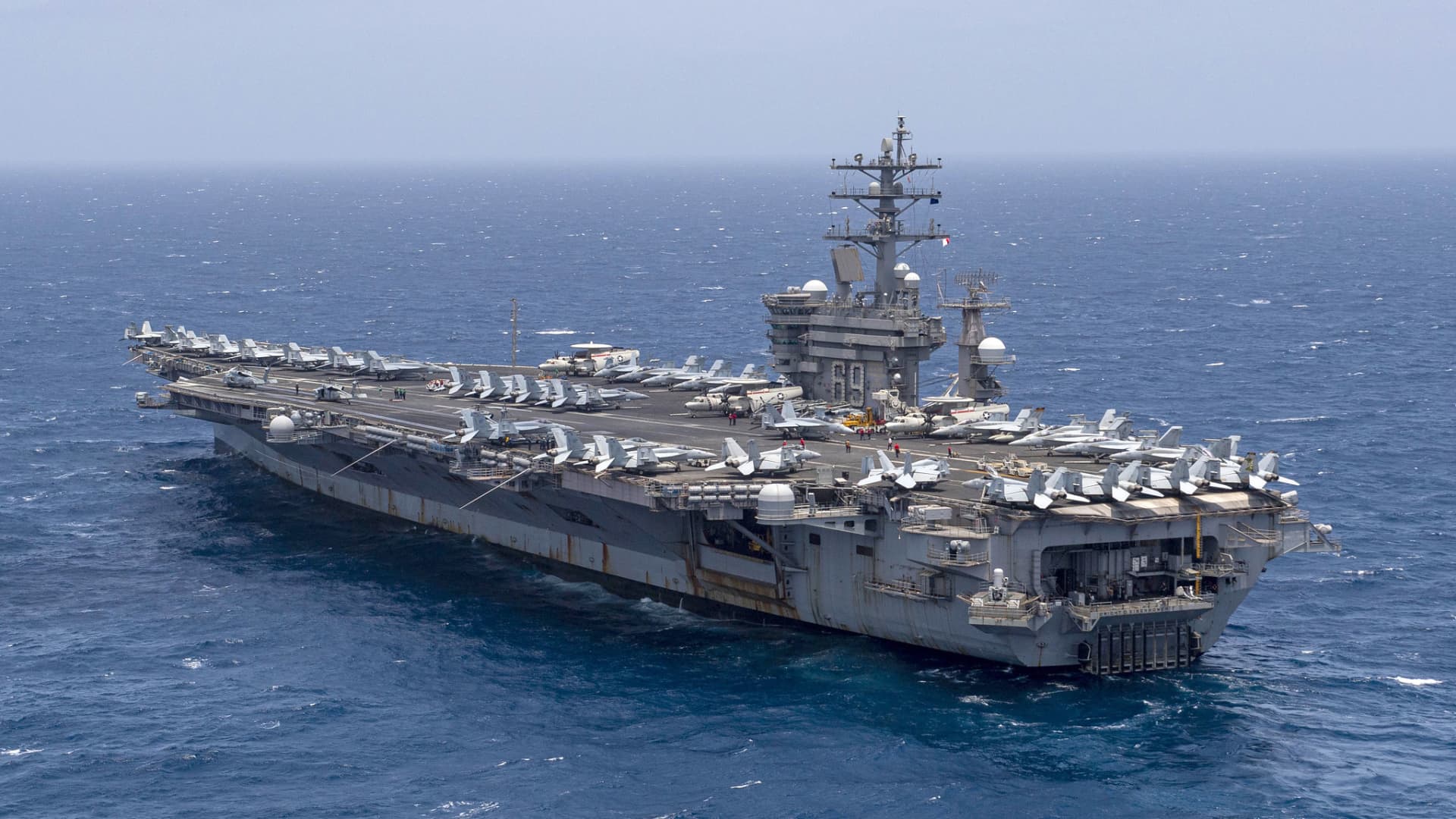The aircraft carrier USS Dwight D. Eisenhower (CVN 69) transits the Arabian Sea, June 12 2020.
US Navy photo
ABOARD THE USS EISENHOWER, the Red Sea — One by one, more than two dozen aircraft—Navy F/A-18 fighter jets, E/A18 Growler radar jammers, E2 Hawkeye reconnaissance planes as well helicopters and tankers—roared off the deck of this aircraft carrier Saturday night to conduct joint U.S.-British attacks on Iranian-backed Houthis.
It was the second night in a row that aircraft from the Eisenhower have targeted Houthi militants in Yemen who are attacking cargo ships in the Red Sea. Earlier in the day, a nearby destroyer, the USS Gravely, fired Tomahawk cruise missiles at the Houthis.
Sailors on another nearby destroyer, the USS Mason, demonstrated the high-speed decision-making needed for them to shoot down incoming Houthi missiles before they strike cargo vessels or U.S. warships.
NBC News is currently the only news organization embedded with the U.S. Navy in the Red Sea while it is conducting strikes.
Adrenaline and morale appeared to be running high among crew members on both U.S. ships, despite the threat of incoming drones or ballistic missiles from the Houthis. As the Eisenhower, Mason and accompanying warships patrol the area, the weather is windy and warm, with a bright sun reflecting off the rippling water surrounding them.
U.S. Central Command said in a statement Saturday that U.S. and U.K. forces had “conducted strikes against 36 Houthi targets at 13 locations” in Yemen that included “multiple underground storage facilities, command and control, missile systems, UAV storage and operations sites, radars, and helicopters.”
Houthi militants based in Yemen have attacked roughly 30 cargo ships navigating the Red Sea since Nov. 19. An estimated 12% of global shipping passes through the strategic waterway daily.
Last month, Maersk and other shipping giants announced pauses in their operations in the Red Sea and the Gulf of Aden, moves that added time and money to the delivery of goods by ship. If the Houthi attacks continue, they could fuel consumer price increases in the U.S. as the 2024 election approaches.
Houthi leaders dismissed the U.S. and U.K. strikes on Saturday and vowed to continue their Red Sea attacks until Israel ends its military operations in Gaza.
“Our military operations against the Zionist entity will continue until the aggression against Gaza stops,” Mohammed Al-Bukhaiti, a Houthi political leader, said. “We will meet escalation with escalation, and victory comes only from God.”
U.S. officials declined to comment on the effectiveness of Saturday’s strikes in Yemen. On Friday, the carrier’s F/A-18 aircraft intercepted multiple drones that Houthi forces were preparing to launch, military officers told NBC News.
The Eisenhower, a vast, 1,000-foot, 100,000-ton Nimitz-class carrier, has a crew of roughly 5,000 and is like a city on the sea, with sprawling aircraft hangars, mess halls and sleeping areas. Launched in 1975, the carrier has circled the globe since then, deploying during the Iran hostage crisis, Operation Desert Storm and other conflicts and crises.
The flight deck of the aircraft carrier USS Dwight D. Eisenhower.
Petty Officer 3rd Class Nathan Beard | US Navy
U.S. officials said that the strikes in Yemen conducted Saturday were separate from the reprisal airstrikes conducted by U.S. aircraft on Friday in Iraq and Syria after three U.S. troops were killed and dozens were injured on a U.S. outpost in Jordan.
Deputy Pentagon press secretary Sabrina Singh vowed that the U.S. would continue its effort to degrade Houthi forces and safeguard shipping in the Red Sea. “We are going to hold those groups accountable who are attacking our forces,” she said on MSNBC. “And of course, we are going to protect commercial shipping through that Red Sea area as well.”
Experts in the region have warned that it is unlikely American airstrikes will be able to destroy all of the ballistic missiles and drones that Iran has supplied to Houthi forces in Yemen. With multiple locations where arms can be hidden in Yemen, including in deep, underground storage areas, U.S. forces are engaged in a cat-and-mouse game with the Houthis.
After the American jets returned safely to the Eisenhower on Saturday, it appeared that many more engagements with the Houthis lay ahead for the carrier and its crew.

